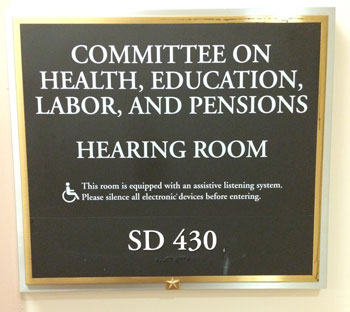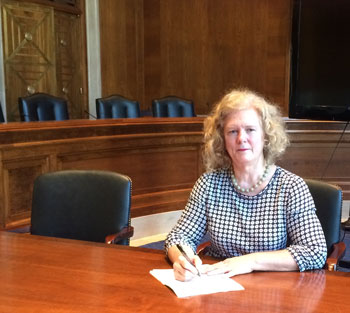Senate Health, Education, Labor & Pensions Committee Working Group Testimony
Testimony by Jan Chambers, President of National Fibromyalgia & Chronic Pain Association
U.S. Senate HELP Committee Prescription Drug Abuse Working Group
Dirksen Senate Building 430
August 27, 2014




On August 27, 2014, three patient advocate experts were called to testify as a panel to the U.S. Senate HELP Committee Prescription Drug Abuse Working Group about the chronic pain patient perspective regarding the use and abuse of prescription medications.
Three panel speakers:
- Jan Favero Chambers, President of National Fibromyalgia & Chronic Pain Association;
- Keysha Brooks-Cooley, Federal Government Relations Director for American Cancer Society, Cancer Action Network; and
- Seth Ginsberg, President of Global Healthy Living Foundation and Creaky Joints
What do you think will be the most valuable information that is unique to the perspectives your organizations offer?
_____________________________________________
_____________________________________________
Jan Chambers: Hello. My name is Jan Chambers, and I am the president of the National Fibromyalgia & Chronic Pain Association. Thank you for the opportunity to add perspectives from people with chronic pain conditions to the serious and weighty responsibility you have to understand how prescription drugs for pain relief are used and abused. We appreciate your sincere interest in the welfare of people with chronic pain and their access to care.
I agree with, and support, the comments that Keysha Brooks-Cooley has provided today and would add the serious need for chronic pain research funding to her five areas of concern. Those five areas, as I heard them, are to:
- improve the effective use of PDMPs (Prescription Drug Monitoring Programs);
- expand and improve physician education about chronic pain and prescribing pain medications;
- create data collection to correctly inform CDC reports and research of prevalence of pain and access to healthcare as well as the unintended consequences of policies--the recent rescheduling of hydrocodones to Schedule II, state legislative actions, and relabeling;
- expand drug take back day so extra medications are not left in medicine cabinets; and
- expand public awareness regarding abuse and misuse of prescription drug medications.
- access to care;
- education about chronic pain illnesses; and
- addiction.
Unintended consequences from restricting access to pain medications have resulted in less access to pain care. Legitimate pain patients are being fired by doctors and turned away at hospital emergency departments because they are seeking pain relief and health care for their conditions. The horrible problems with chronic pain will continue because America has not invested research funding to discover what causes chronic pain. Heart disease, cancer and depression have made tremendous progress towards understanding, prevention, and treatments as a direct result of federal funding for research.
Why haven’t millions of people with chronic pain demanded parity with federal research dollars and joined marches on Washington? People with chronic pain are too ill to participate, and their families are focused on surviving from day to day with the ups and downs of 24/7 chronic pain management.
The war on pain pill abuse is being talked about everywhere. However, no one is talking about the unintended casualties in this war. An estimated 100 million people are diagnosed with life altering and debilitating chronic pain conditions in America. Left untreated, these pain conditions can turn into more serious conditions, lead to higher numbers of people on disability, and worst of all is the very alarming suicidal ideation rate of 38-39% in two recent surveys my organization conducted with over 8,000 people.
In addressing illegal prescription drug abuse, legislators are forgetting about legitimate chronic pain patients who need pain medications to function daily in order to provide for their families and contribute to society. Federal and state legislation aimed at restricting prescription pain relieving drugs is jeopardizing mandatory patients’ rights to adequate treatment and contributing to the stigmatization of chronic pain.
We realize there is a serious problem with addiction to different substances for 24 million people in America, but people with pain illnesses who are using their medications correctly should not have them taken away. Many local physicians who have managed their chronic pain patients for years are sending out letters to these patients saying they will no longer provide health care for them.
Having excruciating pain is a reason to go to an emergency room. Where else should someone go when it’s the middle of the night, they just cannot take the pain any longer, and they need help? Hospital emergency rooms refuse to treat chronic pain or to provide relief. Just last week I spoke with yet another woman who was placed in the psychiatric unit of the hospital for five days when she went to the emergency room crazed with pain and trying to find help.
Chronic pain is a disease according to researcher Dr. Sean Mackey, professor of anesthesiology at Stanford University. “For every year that a brain is in chronic pain, it ages the equivalent of 10 years.” Doctors are not getting that message nor that chronic pain is a disease.
We see that, unfortunately, people with addiction are now turning to heroin since prescription pain meds have become less accessible. Yesterday my hairdresser said she knows of people with chronic pain who are turning to heroin and street drugs because they cannot get pain medications from their doctors. I hear first-hand stories like this often. Her husband has Crohn’s disease and pancreatitis. He takes quick acting pain pills with every meal just to reduce the pain so he can be nourished. In its wisdom, his insurance company decided not to cover the enzyme therapy that helps his Crohn’s disease and increases nutrition. Before they took away his enzyme therapy, he didn’t need to take pain pills with every meal.
He works full time and focuses on getting through the day with the pain. Recently his dosage was reduced for the long-acting pain pills for the pancreatitis. And now this man falls to his knees doubled over with pain in the grocery story because his pain is not managed. His wife is getting desperate because she sees his pain increasing and his health deteriorating. They drive 120 miles every month to see a pain specialist in another city because no one locally will treat his chronic pain conditions. They simply cannot afford to continue the more than $1000 monthly for his pain therapy.
This is just one of the many, many stories I am told. Stigmatization of people with chronic pain conditions is increasing. Ten million people with fibromyalgia have to fight just for a diagnosis. But then what? There is no cure or understanding of how to treat it. One of the world’s experts on fibromyalgia, Dr. Daniel Clauw, recently put together a YouTube video. Essentially, he says to viewers, “You’re responsible for managing this condition, folks. Work with your doctor to try different pain meds, eat better, move daily, and try to think positively. Here are some ways to do that.” Why is a world medical expert saying this? Because there is virtually no funding for fibromyalgia research to find a cause, treatments, or a cure.
Living with a chronic pain condition is like living in a house made from a deck of cards. It’s fragile and when one of the cards falls, the house falls. Lack of sleep from pain, stress, inadequate pain treatments, social stigmas, depression, and a flare from pain must be delicately balanced.
Let’s talk about how stigma affects the 100 million American adults and their families.
People with fibromyalgia or other chronic pain conditions are often stuck in stigma purgatory: If they rest or nap because of pain, others think they rest or nap too much; if they are caught crying because of chronic pain, observers become impatient and think they cry too much; if they don’t work because of pain, they face scrutiny over why they don’t work; if they visit a healthcare provider, someone might ask, “Are you going to the doctor - again?”
People with chronic pain conditions might be viewed as taking too many medications and can be accused of having drug-seeking tendencies. Any of these reactions reveal disapproval of how a person is coping with chronic pain. These disapproving judgments propagate the stigma of living with fibromyalgia and chronic pain.
Cultural stigmatization, or disapproving judgment, sometimes is conveyed through disbelief that anyone could suffer the amount of pain described, which then calls into question the legitimacy of resting, napping, crying, taking narcotics, unemployment or seeing a physician, etc. At this point, a chronic pain patient’s personal awareness can integrate this judgmental attitude into their own concepts of living with these conditions, which unintentionally becomes personal stigmatization.
Thank you for your time and attention to my comments today. Millions of people with chronic pain need your help. Significant research is needed to understand chronic pain, its cause, and how to treat it. If we had adequate pain treatments now, we wouldn’t have 100 million American adults with chronic pain conditions. The cart is before the horse by simply expanding more of what we do now without new scientific knowledge of chronic pain for better treatments. People who take any pain medications want to know they will be safe when taking them. We need more research on chronic pain and addiction.
_____________________________________________
Paraphrased testimony follow-up questions and answers:
1. Do you have creative solutions on how to improve safety and effectiveness of opioid medications?
Jan Chambers: I believe that more sensitive urine and blood tests will help physicians and patients understand the efficacy of the pain medications prescribed. Titration could be adjusted depending on metabolism. Legitimate patients with chronic pain are not afraid to take drug tests. They often cannot afford them as often as they are required. The current tests are being used in a manner of a criminal setting where people have to prove they are compliant rather than a setting where they increase safety and effective pain relief. Using better tests will save money and lives.
CMS (Center for Medicaid and Medicare Services) needs to be more open minded about the type of tests and medications it is willing to pay for within the Medicare and Medicaid system. Our most vulnerable population is those in the Medicaid system seeking pain relief. Generic opioids with no abuse deterrent formulations and methadone are prescribed to them. They don’t have options for safer medications and treatments. If people had better pain management, it’s likely their productivity would increase, and they wouldn’t need as much financial help through Medicaid.
Educate doctors on prescribing and also teach patients about safe and effective use of narcotics. This is necessary to preserve prescribing authority of pain medications. Doctors are very concerned about the actions of the DEA, state legislatures, and state licensing boards towards their prescribing licenses. To protect their licenses, physicians turn away patients with chronic pain rather than risk defending their prescribing patterns. This affects patient access to care. This is not just about accessing opioid medications. It goes further to patients not having access to physicians who will treat them, period.
2. What would you want the media to do differently when reporting stories about patients and opioid medications?
Jan Chambers: Report the big picture. Patients are hesitant to discuss full health issues with their physicians for fear they will be fired as patients, have less access to pain medications, and that they will not have pain relief. There is supposed to be a partnership between a doctor and patient to decide the best plan for pain relief and functionality. By media reporting only about patients who become dependent and sometimes addicted on pain medications, the image of people who legitimately and safely use prescription opioids is wrong. These are everyday citizens who are trying to provide for themselves and their families. We are being stigmatized by the media, and it affects the fabric of America.
3. How do you think the Prescription Drug Abuse Working Group of the Senate Health Education Pensions & Labor Committee could be of the most help to the people you represent?
Jan Chambers: Keysha’s point of monitoring the consequences of the new policies from the federal and state governments is crucial. My organization, the National Fibromyalgia & Chronic Pain Association, has followed the effects on access to pain care and medications. But that is not our responsibility. This seems to be the responsibility of the FDA. Those good folks are trying to help us, and we need them to step out further to assess the impact of these new and upcoming policies affecting opioid prescriptions.
People hold on to any extra pain medications they can set aside so they can manage unexpected breakthrough pain or if they run out of medication before they can get to the pharmacy on the 30th day. People are chained to that 30-day prescription refill at the pharmacy. They can’t go out of town and refill it at a different pharmacy or they would be breaking the contract with their physician to fill the prescription only at a designated pharmacy. And if the 30-day mark lands on a weekend or a holiday, people can go several days without their pain medication, which sends them into withdrawal symptoms. Then the pain is not managed again, and this puts them into the pain symptom cycle – more pain, less sleep, fear, anxiety, etc. This symptom cycle harms people.
If the pharmacy doesn’t have enough supply of the pain medication to fill the prescription, the patient has to personally return several times. They cannot call on the telephone and ask if the drug is available because the pharmacy won’t give that information over the phone. Often the person with the chronic pain condition had to depend on someone to give them a ride to the pharmacy, and this extra physical stress to get to the pharmacy several times is hard for them. When they show up looking awful, the pharmacist suspects they are drug-seeking. And their pharmacy records look like they’ve been pharmacy hopping when they go to several different retail outlets of a chain pharmacy (which is often 4 or 5), just to fill the current month’s prescription.
When someone using Schedule II pain medication relocates or changes physicians, they have to establish a trusting relationship with a new physician immediately to maintain the 30-day pain medication mandate for access to their pain medication. That’s just not realistic with the skepticism physicians have towards people with chronic pain. A physician seeing a new chronic pain patient is not likely to continue the same medication regimen as the previous physician. It’s realistic to expect more uncontrolled pain and pain cycle symptoms until a new, trusting relationship and regimen is established.
Patients want to feel safe about taking strong pain relief medication. I suggest that after a new opioid prescription is filled, a follow-up call from the physician or pharmacist to ask how the patient is doing is very important. Educating the patient and sending them home with a talking points list is important. People aren’t confident about safely starting these powerful medications without an opportunity to report their experiences with them. They are depending on their physician to safely prescribe for them. In the face of the brain seizing pain, however, patients are willing to set aside their concerns and take the drugs to try to stop the pain.
Taking longer-acting medications means fewer pills to manage and less attention on the cycles of pain as they increase and lessen with the short-acting dosage.
(For further reference, please go to: http://www.help.senate.gov/newsroom/press/release/?id=3ba878ea-1724-4f96-a2fd-bcc748f4182d.)





